The evolution of analytics: from Track ID to speech recognition
Marketers have long learned to analyze the behavior of users of online stores: where they came from, what requests and what they did on the site. However, not all visitors buy products through online forms, it is more convenient for someone to place an order by phone and, until recently, it was almost impossible to track and analyze the sources of these calls. Today, this function is performed by call tracking. You will learn how to build a call analytics system and optimize advertising campaigns in this article.
Story
Attempts to track the sources of calls began with Track ID - this is the technology that assigned to each site visitor a specific number corresponding to its user session, for example, a basket or order code. This number was reported to the call center operator by telephone. Thus, marketers understood where the visitor came from.
However, Track ID had several drawbacks. First, the operation of the system depended on the person who could make a mistake. For example, there were cases when, in the absence of a bosses, operators noted the same source for all of the callers or said that they refused to name him. Secondly, it’s not convenient for every user to search the code on the site.
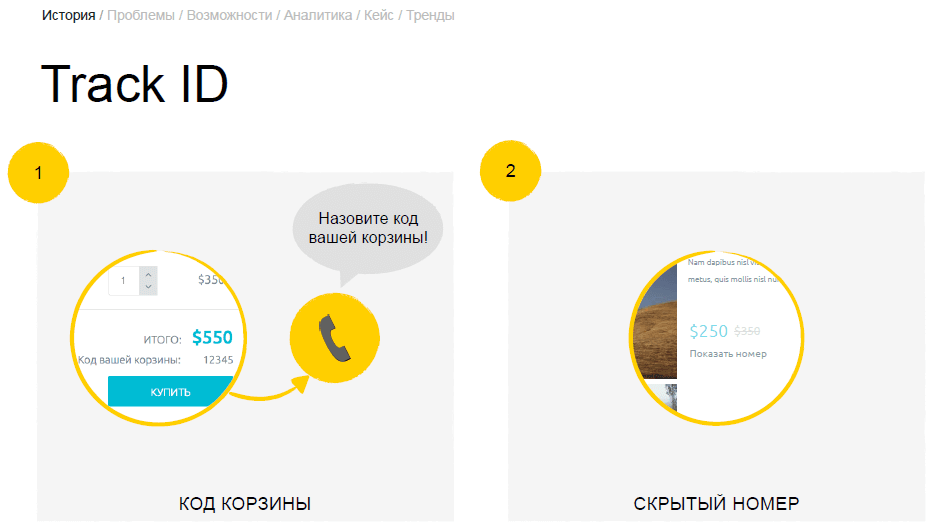
')
This technology could also use hidden numbers that were displayed when the “Show number” button was clicked. The system tracked callers, but there were some drawbacks. Many companies considered such an approach undignified and refused to hide numbers. In addition, statistics showed that only 50% of users who pressed the button, then made a call.
Because of these shortcomings, Track ID gave about 30-40% of the error, not allowing an objective analysis of advertising sources, complicated the work of the call center, and in 2011 it was replaced by call tracking.
Static Call Tracking
The essence of statistical call tracking is that different numbers are used in different advertising sources. For example, visitors who came from the context, see the phone number ending in 01, from SEO - to 02, and from banner advertising - to 03. By counting the number of calls for each number, you can evaluate the advertising channels without additional workload and errors.
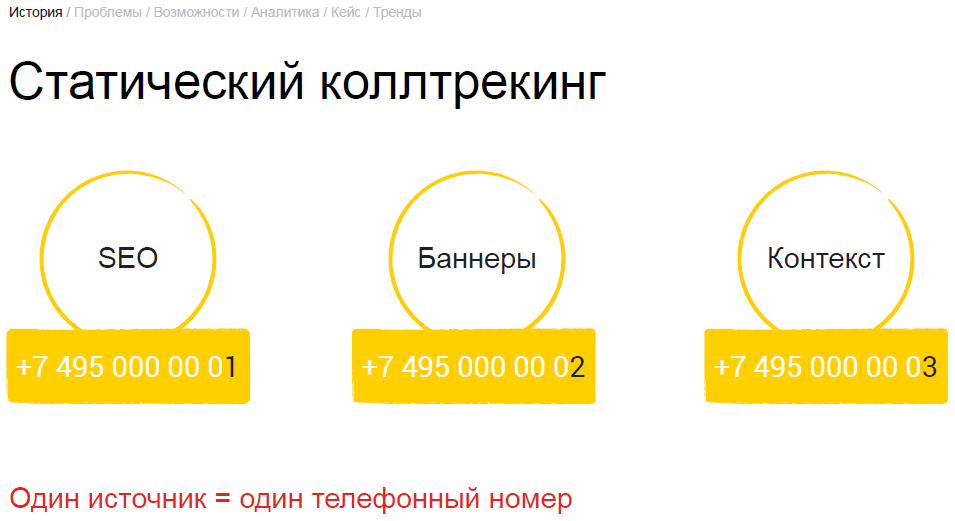
Static call tracking allows you to do a primary analysis, but this data is not enough for serious analytics. Thus, a competent assessment of the effectiveness of contextual advertising with its help is possible when allocating different numbers for different groups of requests. However, for small companies, such a volume will be very expensive, and for large ones it will not provide the necessary detail. To solve these problems, in 2012, Calltouch was the first company on the Russian market to launch a dynamic call tracking service.
Dynamic Call Tracking
It differs from static one in that telephone numbers are not assigned to advertising channels, but to each one-time user of the site: if 100 people log on to it at the same time, they will see different phones.
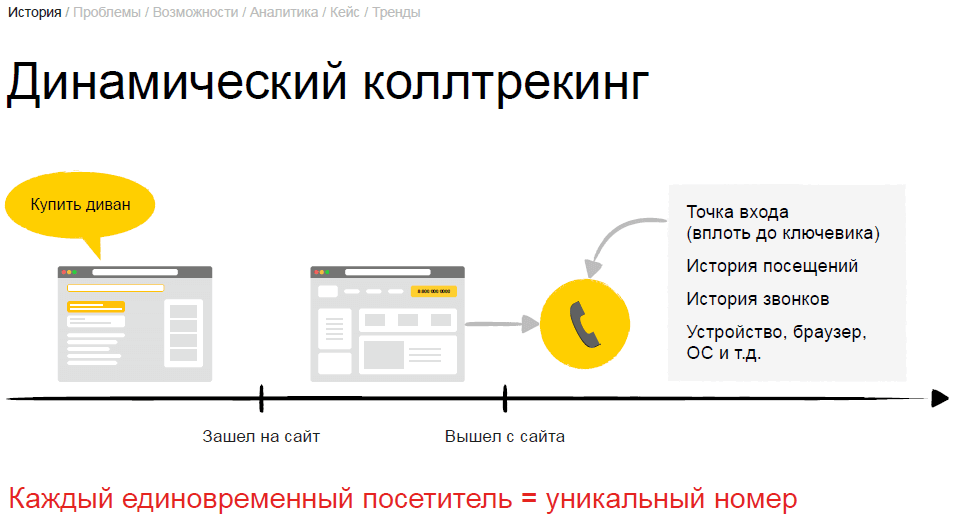
The service works on the following principle. As soon as a potential client enters the site, Calltouch assigns him a specific number for the entire time that the person is on the site, and a short time after the tab is closed. If he calls, you can understand that at this time a unique number was assigned to a specific user session. It will show that, for example, a user came from an ad to Yandex.Direct on the request “Buy a sofa”, visited the site 4 times and called 1 time, lives in Moscow, uses the Andriod phone and Google Chrome browser. Such a detailed report helps to understand the portrait of a potential client and the requests for which he applies. It remains only to compare the cost of attracting users from different sources and, based on these data, optimize advertising.
Imaginary problems
Naturally, during the time it entered the market, Calltouch ran into a number of objections from advertisers, which were subsequently removed.
Objection number 1 : unwillingness to change the "beautiful" number.
Many companies are trying to get a simple number that is easily remembered and they don’t want to lose it, because they have spent money on it and many customers know it.
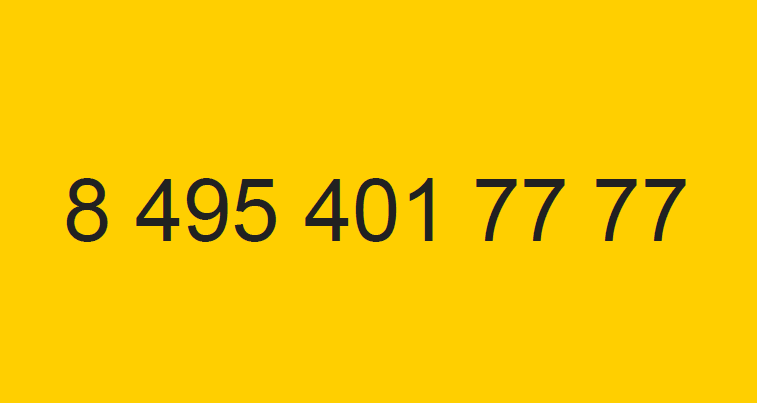
Solution : you can continue to use the “beautiful” number, but not in online advertising, but, for example, on a radio or TV. The rest of the visitors who come to the site from online advertising, it is more logical to show substitute numbers to determine the source. The most demanding advertisers can use "beautiful" replacement numbers.
Objection number 2 : the user can write down the number and call later.
Some people keep a company number, but call in a few weeks or even months.
Solution : In this case, you can understand from which source the visitor came, but it is impossible to determine the request. However, according to Calltouch statistics, no more than 4% of users record numbers of commercial companies, the rest go to the Internet to the site and watch the number. The phone is stored not earlier than the third or fourth contact with the company and the task of the marketer is to find out which source was the first.
Objection number 3 : not all calls are equally useful.
Companies that sell products and are engaged in their service, can not analyze all incoming calls.
Solution : separation of service calls and calls related to sales.
Determination of target calls
The first method is a voice menu that prompts the customer to choose the reason for which he calls by pressing a number from 1 to 9. For example, if the call is related to a purchase, the customer needs to press 1, if with the service, 2. Thus, all calls, received by the number 1, call tracking marks as sales, and the remaining calls are not taken into account in the data analysis.
The second method is used in the event that the company is afraid that customers will scare off the automatic voice menu. The call center operator can receive the call and, depending on which category the call belongs to (service or purchase), forward it to the appropriate department. As in the case of the voice menu, when analyzing the sources of calls, Calltouch will take into account only those who received the number 1.
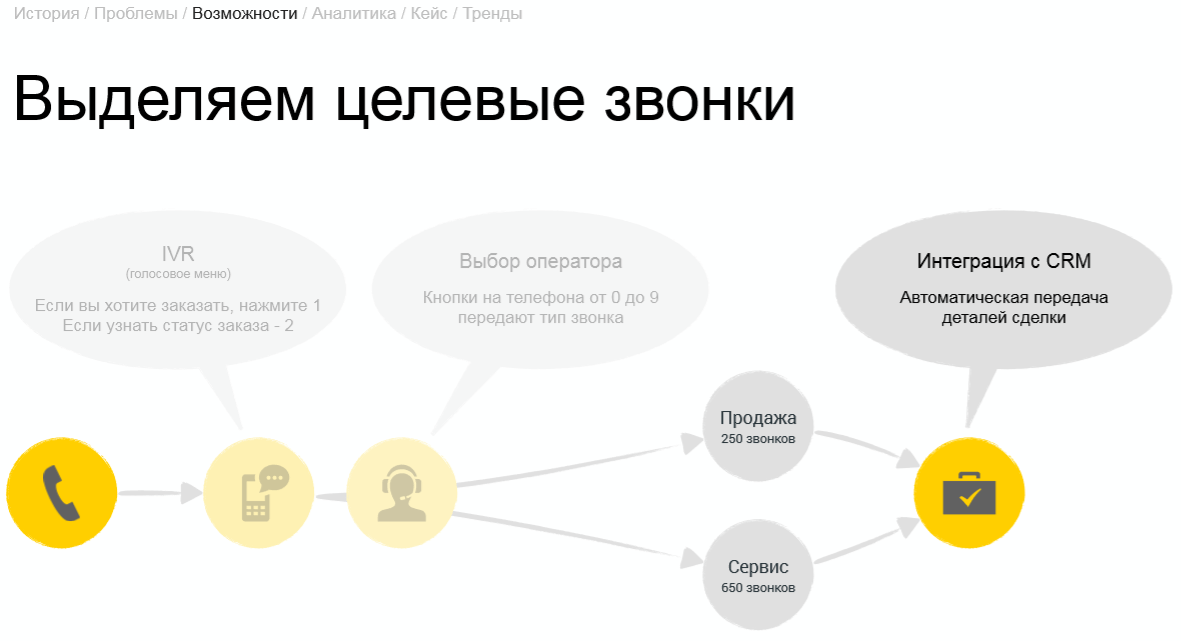
When working on both models, integration with CRM will show how much it costs to attract one client and how much profit each source of advertising brings.
Opportunities
First of all, dynamic call tracking helps to analyze the effectiveness of various advertising sources. Better to start with contextual advertising, because it is the most costly, but at the same time easily manageable channel. The key words are analyzed, problem areas are identified, work is done with the texts of the landing pages and the stakes on words of different effectiveness - all this will help to highlight 11% of the key words, which, as a rule, bring the bulk of hits. They should be used as much as possible when creating ads in context, including in special placements. At the same time, based on the statistics of calls, you can determine the optimal time for advertising: at what time it brings the most number of targeted calls.

The service makes it possible to compare the effectiveness of various website page designs. For example, there are two options for the layout of the landing page, and by the number of "selling" calls, you can determine which one is the most effective.
Also, dynamic call tracking helps optimize call center operation: shows how managers use scripts, work with objections, and what is the optimal time for a call center. For example, a company selling luxury real estate lost 20% of calls, because employees came to work by 9 am, and calls started at 7 am — at this time, potential customers from distant regions called for an apartment in Moscow.
Analytics
During the existence of Calltouch, about 900 million visits and 14.5 million calls (calls and requests, chats) were analyzed. As a result, it turned out that about 70% of all calls are unique - a person called the company for the first time, and the remaining 30% are people who have already called 3-6 times. Thus, there is only one chance to make an impression on a potential client, and if you make a mistake in a conversation, you can lose it.
As a rule, 20-30% of requests come through online applications. At the same time, purchases made through calls have an average check higher than those who came from the application. This results from the fact that the person who ordered the refrigerator will buy only it and will hardly pay attention to the offered accompanying goods. By telephone, people are more willing to accept the advice of operators and buy additional goods.
According to the analysis of advertising campaigns for all the accumulated data, it was revealed that the average conversion into the treatment of contextual advertising averaged 1.83%, with organic search - 1.65%, and with direct visits - 0.91%.
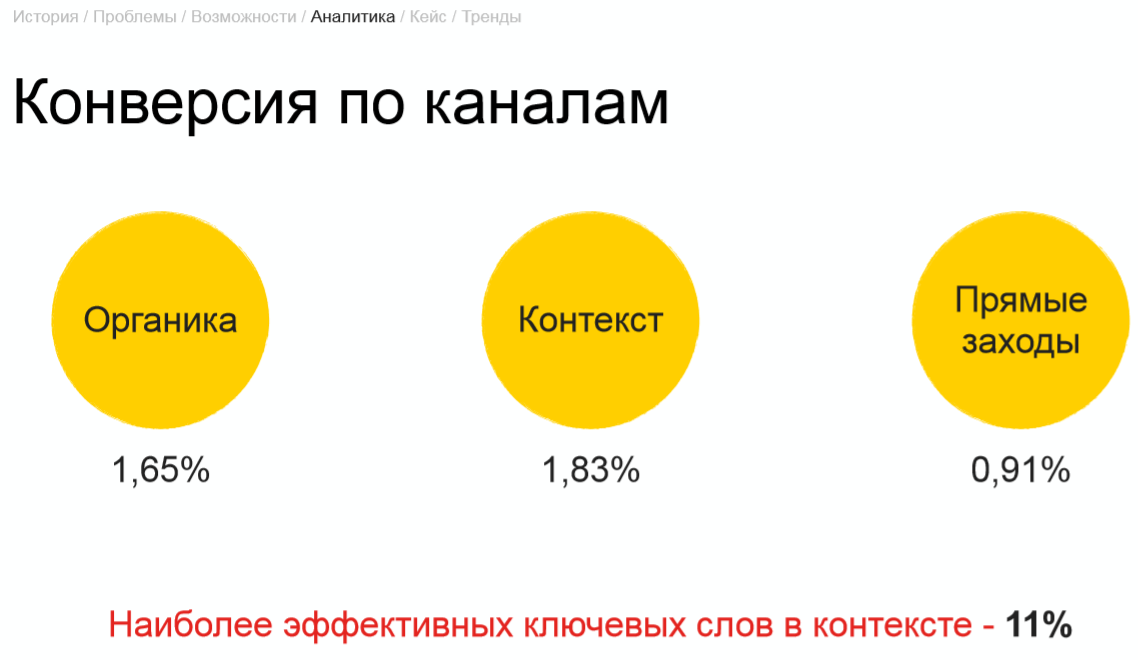
Calltouch also investigated channel conversion in three popular areas: cars, real estate, and medicine. Organic search results were higher than others, because among the companies studied are sites with a long history of SEO promotion. In contextual advertising, medicine has shown the best result - in this field, marketers have long been analyzing calls and their sources.

In general, a large number of companies in the market operate with an average conversion from the context of 0.5-0.7%, and this suits them. At the same time, others in the same subject achieve a conversion of 4-6%. Thus, it is immediately possible to understand who uses the data from the analysts of the sources of requests, and who simply looks at them.
Case
Let us consider the advantages of dynamic call tracking using the example of the official BMW dealer - Avtodom company. For the first three weeks, statistics were collected, mainly standard contextual advertising work was carried out: error correction, correct UTM markup, grouping and writing ads, and so on. According to the results of the first three weeks, the average hourly conversion was determined on the basis of statistics - the peak was in the period from 12 to 13. Further, work began on reducing and increasing the rates for various keywords depending on efficiency.
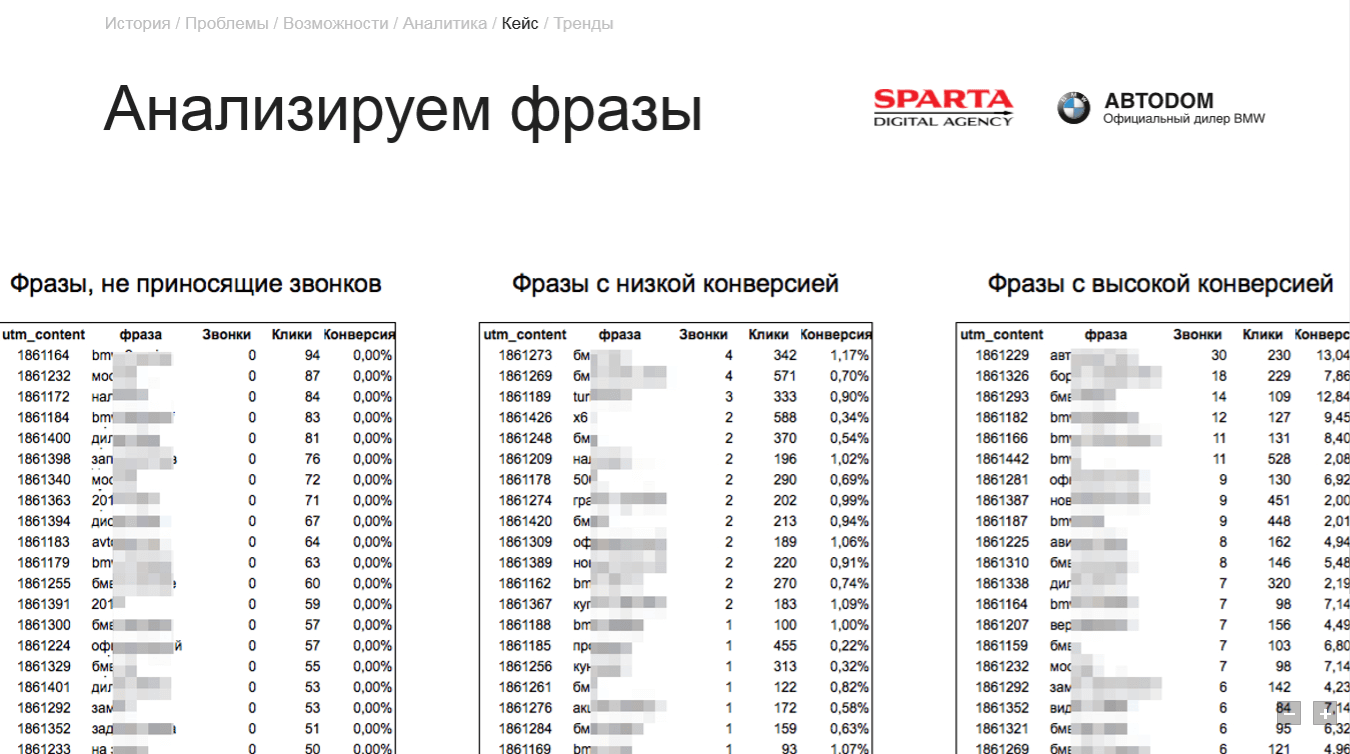
After six weeks of work, they were divided into three groups: effective (within the target cost), medium effective (give circulation at too high a price) and ineffective (no circulation). To optimize advertising campaigns, the main budget was redistributed to effective words.
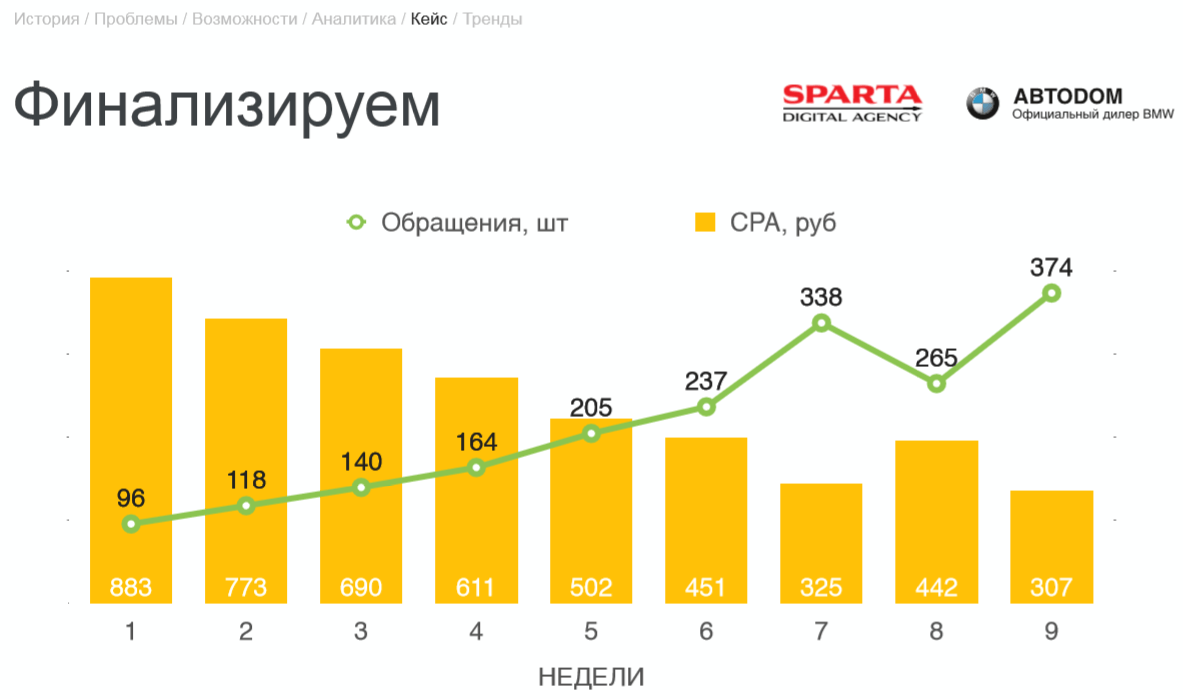
On the eighth week, the advertiser asked why, according to certain requests, his site was not in the top and, despite explanations that they were ineffective, insisted on using them in special accommodations. Because of this, the cost of circulation increased by 40%. On the ninth week, the campaign returned to the original plan and as a result, the cost of circulation decreased 3 times, and the number of calls increased 4 times.
Trends
Automation of advertising and its analytics is developing very rapidly, so Calltouch predicts serious breakthroughs in the near future, for example, the development of end-to-end analytics. Some large companies are already tracking the movement of users, ranging from visiting the site and ending with the purchase in an offline store.
Another trend of the future is speech recognition. The technology will automatically separate “selling” calls from service calls, monitor call center operation and analyze words that customers use in conversation. These tools will help to further analyze the advertising and user behavior in telephone conversations.
Story
Attempts to track the sources of calls began with Track ID - this is the technology that assigned to each site visitor a specific number corresponding to its user session, for example, a basket or order code. This number was reported to the call center operator by telephone. Thus, marketers understood where the visitor came from.
However, Track ID had several drawbacks. First, the operation of the system depended on the person who could make a mistake. For example, there were cases when, in the absence of a bosses, operators noted the same source for all of the callers or said that they refused to name him. Secondly, it’s not convenient for every user to search the code on the site.

')
This technology could also use hidden numbers that were displayed when the “Show number” button was clicked. The system tracked callers, but there were some drawbacks. Many companies considered such an approach undignified and refused to hide numbers. In addition, statistics showed that only 50% of users who pressed the button, then made a call.
Because of these shortcomings, Track ID gave about 30-40% of the error, not allowing an objective analysis of advertising sources, complicated the work of the call center, and in 2011 it was replaced by call tracking.
Static Call Tracking
The essence of statistical call tracking is that different numbers are used in different advertising sources. For example, visitors who came from the context, see the phone number ending in 01, from SEO - to 02, and from banner advertising - to 03. By counting the number of calls for each number, you can evaluate the advertising channels without additional workload and errors.

Static call tracking allows you to do a primary analysis, but this data is not enough for serious analytics. Thus, a competent assessment of the effectiveness of contextual advertising with its help is possible when allocating different numbers for different groups of requests. However, for small companies, such a volume will be very expensive, and for large ones it will not provide the necessary detail. To solve these problems, in 2012, Calltouch was the first company on the Russian market to launch a dynamic call tracking service.
Dynamic Call Tracking
It differs from static one in that telephone numbers are not assigned to advertising channels, but to each one-time user of the site: if 100 people log on to it at the same time, they will see different phones.

The service works on the following principle. As soon as a potential client enters the site, Calltouch assigns him a specific number for the entire time that the person is on the site, and a short time after the tab is closed. If he calls, you can understand that at this time a unique number was assigned to a specific user session. It will show that, for example, a user came from an ad to Yandex.Direct on the request “Buy a sofa”, visited the site 4 times and called 1 time, lives in Moscow, uses the Andriod phone and Google Chrome browser. Such a detailed report helps to understand the portrait of a potential client and the requests for which he applies. It remains only to compare the cost of attracting users from different sources and, based on these data, optimize advertising.
Imaginary problems
Naturally, during the time it entered the market, Calltouch ran into a number of objections from advertisers, which were subsequently removed.
Objection number 1 : unwillingness to change the "beautiful" number.
Many companies are trying to get a simple number that is easily remembered and they don’t want to lose it, because they have spent money on it and many customers know it.

Solution : you can continue to use the “beautiful” number, but not in online advertising, but, for example, on a radio or TV. The rest of the visitors who come to the site from online advertising, it is more logical to show substitute numbers to determine the source. The most demanding advertisers can use "beautiful" replacement numbers.
Objection number 2 : the user can write down the number and call later.
Some people keep a company number, but call in a few weeks or even months.
Solution : In this case, you can understand from which source the visitor came, but it is impossible to determine the request. However, according to Calltouch statistics, no more than 4% of users record numbers of commercial companies, the rest go to the Internet to the site and watch the number. The phone is stored not earlier than the third or fourth contact with the company and the task of the marketer is to find out which source was the first.
Objection number 3 : not all calls are equally useful.
Companies that sell products and are engaged in their service, can not analyze all incoming calls.
Solution : separation of service calls and calls related to sales.
Determination of target calls
The first method is a voice menu that prompts the customer to choose the reason for which he calls by pressing a number from 1 to 9. For example, if the call is related to a purchase, the customer needs to press 1, if with the service, 2. Thus, all calls, received by the number 1, call tracking marks as sales, and the remaining calls are not taken into account in the data analysis.
The second method is used in the event that the company is afraid that customers will scare off the automatic voice menu. The call center operator can receive the call and, depending on which category the call belongs to (service or purchase), forward it to the appropriate department. As in the case of the voice menu, when analyzing the sources of calls, Calltouch will take into account only those who received the number 1.

When working on both models, integration with CRM will show how much it costs to attract one client and how much profit each source of advertising brings.
Opportunities
First of all, dynamic call tracking helps to analyze the effectiveness of various advertising sources. Better to start with contextual advertising, because it is the most costly, but at the same time easily manageable channel. The key words are analyzed, problem areas are identified, work is done with the texts of the landing pages and the stakes on words of different effectiveness - all this will help to highlight 11% of the key words, which, as a rule, bring the bulk of hits. They should be used as much as possible when creating ads in context, including in special placements. At the same time, based on the statistics of calls, you can determine the optimal time for advertising: at what time it brings the most number of targeted calls.

The service makes it possible to compare the effectiveness of various website page designs. For example, there are two options for the layout of the landing page, and by the number of "selling" calls, you can determine which one is the most effective.
Also, dynamic call tracking helps optimize call center operation: shows how managers use scripts, work with objections, and what is the optimal time for a call center. For example, a company selling luxury real estate lost 20% of calls, because employees came to work by 9 am, and calls started at 7 am — at this time, potential customers from distant regions called for an apartment in Moscow.
Analytics
During the existence of Calltouch, about 900 million visits and 14.5 million calls (calls and requests, chats) were analyzed. As a result, it turned out that about 70% of all calls are unique - a person called the company for the first time, and the remaining 30% are people who have already called 3-6 times. Thus, there is only one chance to make an impression on a potential client, and if you make a mistake in a conversation, you can lose it.
As a rule, 20-30% of requests come through online applications. At the same time, purchases made through calls have an average check higher than those who came from the application. This results from the fact that the person who ordered the refrigerator will buy only it and will hardly pay attention to the offered accompanying goods. By telephone, people are more willing to accept the advice of operators and buy additional goods.
According to the analysis of advertising campaigns for all the accumulated data, it was revealed that the average conversion into the treatment of contextual advertising averaged 1.83%, with organic search - 1.65%, and with direct visits - 0.91%.

Calltouch also investigated channel conversion in three popular areas: cars, real estate, and medicine. Organic search results were higher than others, because among the companies studied are sites with a long history of SEO promotion. In contextual advertising, medicine has shown the best result - in this field, marketers have long been analyzing calls and their sources.

In general, a large number of companies in the market operate with an average conversion from the context of 0.5-0.7%, and this suits them. At the same time, others in the same subject achieve a conversion of 4-6%. Thus, it is immediately possible to understand who uses the data from the analysts of the sources of requests, and who simply looks at them.
Case
Let us consider the advantages of dynamic call tracking using the example of the official BMW dealer - Avtodom company. For the first three weeks, statistics were collected, mainly standard contextual advertising work was carried out: error correction, correct UTM markup, grouping and writing ads, and so on. According to the results of the first three weeks, the average hourly conversion was determined on the basis of statistics - the peak was in the period from 12 to 13. Further, work began on reducing and increasing the rates for various keywords depending on efficiency.

After six weeks of work, they were divided into three groups: effective (within the target cost), medium effective (give circulation at too high a price) and ineffective (no circulation). To optimize advertising campaigns, the main budget was redistributed to effective words.

On the eighth week, the advertiser asked why, according to certain requests, his site was not in the top and, despite explanations that they were ineffective, insisted on using them in special accommodations. Because of this, the cost of circulation increased by 40%. On the ninth week, the campaign returned to the original plan and as a result, the cost of circulation decreased 3 times, and the number of calls increased 4 times.
Trends
Automation of advertising and its analytics is developing very rapidly, so Calltouch predicts serious breakthroughs in the near future, for example, the development of end-to-end analytics. Some large companies are already tracking the movement of users, ranging from visiting the site and ending with the purchase in an offline store.
Another trend of the future is speech recognition. The technology will automatically separate “selling” calls from service calls, monitor call center operation and analyze words that customers use in conversation. These tools will help to further analyze the advertising and user behavior in telephone conversations.
Source: https://habr.com/ru/post/291648/
All Articles